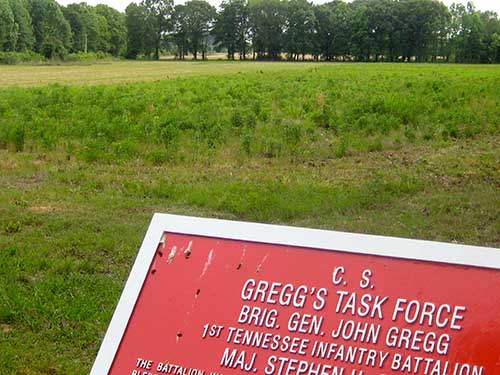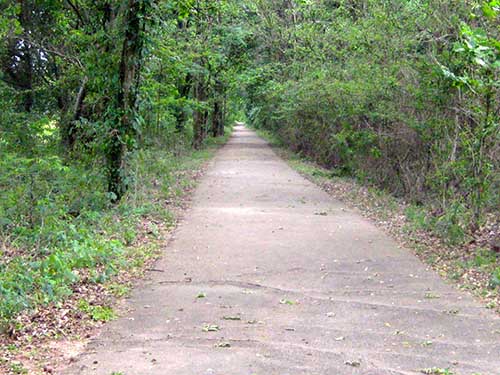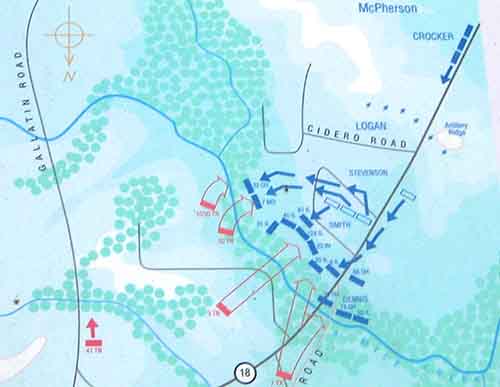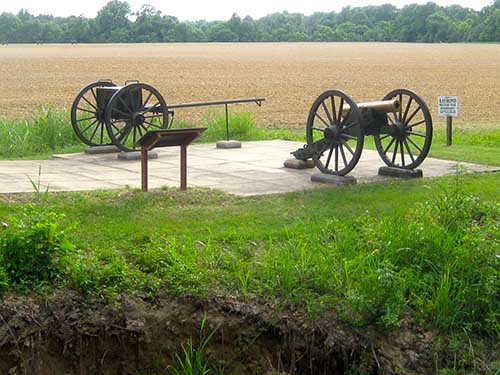
We were walking the paved loop around the core battlefield at Raymond. It was a sunny Mississippi afternoon, the air languid and soft against our skin. There was another walker on foot, maybe a quarter mile ahead, and a jogger over by the abandoned concrete road and bridge across Fourteen Mile Creek.
“The Raymond battlefield had remained nearly unchanged for over a century,” said my friend. “Certainly in the time my father lived here. But the sprawl of development even came to sleepy country Mississippi in this new century. The improvement of Route 18- you can hear traffic from it beyond the trees- was resulting in commercial and residential development. That new activity vaulted this field up to one of the Top Ten endangered Civil War battlefields, according to the people at the Preservation Trust.”
“I have belonged to the Trust for a long time, and I am always good- or at least was- for a twenty spot to support good works.” I looked at the remains of what had been a bridge across a little tributary stream. “Do you think that was here in 1863?” I said, gesturing at the tangle of vines and fallen beams.
“I don’t know. This is probably the path of the old farm road,” he said, pointing down the narrow paved lane that ran straight as a die toward the end of the property.

“I donated specifically to the Raymond fund-raising campaign, and a fairly significant check to help purchase the high-ground at Brandy Station, where that jerk built the McMansion Spite House on the site of J.E.B. Stuart’s headquarters,” I said. “It does my heart good to see the crest of that hill naked again when I drive by.”
“Me too. It was in 1998 that plans were announced to pave over the pastures and put a strip mall fronting the highway. The people of Raymond got alarmed at the idea, and a group of concerned citizens formed the Friends of Raymond. They raised enough money to purchase forty acres that was going to be developed, and started buying other chunks of property along the battle lines.”
I looked to the left, at the peaceful green pasture that had been the line of advance toward Fourteen Mile Creek, and tried to imagine what it would have been like with a Seven Eleven, a gas station and a Dollar Store on it.
“So, they just about doubled the size, to include the area where your Uncle fought. We will go over there later, and I think I can find it. They put up a marker, but I had to trespass to get to it last time. We will have to approach from the south.”
We walked along and I began to sweat. “I am glad we are not here for the actual anniversary,” I said. “I bet on Tuesday there is going to be a big deal. I prefer to contrast the tranquility of the present with the idea of the chaos of the past.”
“The terrain hasn’t changed, of course, but the roads and trees have. I think this path was the road the Union troops came up to confront General Brig. Gen. John Gregg’s force. You can see there is a part that goes beyond the park boundary, and the remains of another bridge. The concrete road over there replaced it, I think, and ultimately the new Highway 18 was constructed off beyond the trees. The battle lines ran from off the Battlefield property to our right across the two newer roads. And the trees around us were not here, since we can’t see the Confederate cannon behind us on the bluff.”

“It is hard to figure out what you are looking at without seeing an old-time map superimposed on the modern features.”
My friend nodded as we came to a sign telling us not to go any further down the lane that crossed the stream. Another ancient wooden structure had fallen into the stream, and the asphalt walking path turned sharply to the left, paralleling the creek.

My friend went beyond the sign and told me to come with him. We stood and looked down the steep banks of the watercourse. “This is the major feature of the field. It was a natural trench. Gregg’s men had to cross it, charging the Yankees when they thought they had the advantage on them. The other units were arrayed on the high ground across the modern roads.”
“This is a great natural fortification,” I said looking at the tree sheltered streambed. The steep sides were at least ten feet above the foot or so of water flowing languidly through the rocks and fallen limbs. “But to advance across it and then have to fall back. Jesus.”
“Yeah. Gregg thought he was facing a much smaller force when he launched his attack at the Union front. He thought he was going to roll up a Union brigade. Instead, he was assaulting the front of an entire Union Army Corps. There were 12,000 Federals pouring up the road against his 4,000.”
We walked the quarter mile up to the 1920s-era Paper Moon-style bridge. On the other side of the creek were two cannon, placed to note the flying advance of the Michigan artillery. On the high ground of the field to the south were arrayed the snouts of twenty Union cannon.
“God, this was a killing field.”
My friend nodded. “Yes it was. Look at Fourteen Mile Creek from here,” and pointed to the deep chasm that provide natural protection for the Union advance as the Confederates were hurled back toward Raymond.
“Heavy fighting broke out along the slopes and low ground as the two forces collided in clouds of smoke and dust. It was a fog of war,” my friend said thoughtfully. “And I mean that literally. The stalemate here at the creek was finally broken when General McPherson massed his artillery and began delivering barrage on Gregg’s men. These Michigan guns were probably firing grape shot, mowing down the Rebels.”

“Not a pretty sight, I imagine. What made them stand and not run?”
“Well, they did, eventually, but heavy battle smoke and difficult ground prevented Gregg from knowing he was facing a buzz saw. The Texans to our right and the Tennessee Irish were moving in echelon toward the center, where the bulk of the fighting was happening.”
More than 500 Confederate soldiers were killed, wounded or missing on the field. Slightly less for the Union. Still, it was a sharp encounter. And the vigor of Gregg’s attack convinced U.S. Grant that he could not drive from here to Vicksburg and leave the Confederates in Jackson at his back. This fight changed the course of the campaign. Grant went against Jackson, and that forced the battle at Champion Hill, a much larger engagement than this was.”
“Good to know. This fight was it for Uncle Patrick. He got captured again as a result of some heroics. His unit was on the high ground off across Highway 18, right?”
“Yes. I think I can find it. We may have to trespass. You up for it?” We started the walk back around the field to the car. The air was humid, but not oppressively hot. The field was peaceful, and we were alone on the field.
“Hell, yes,” I said. “I just hope no one shoots us. That would be too ironic.”
My friend just smiled.
Tomorrow: Where McGavock Fell
Copyright 2015 Vic Socotra
www.vicsocotra.com
Twitter: @jayare303
